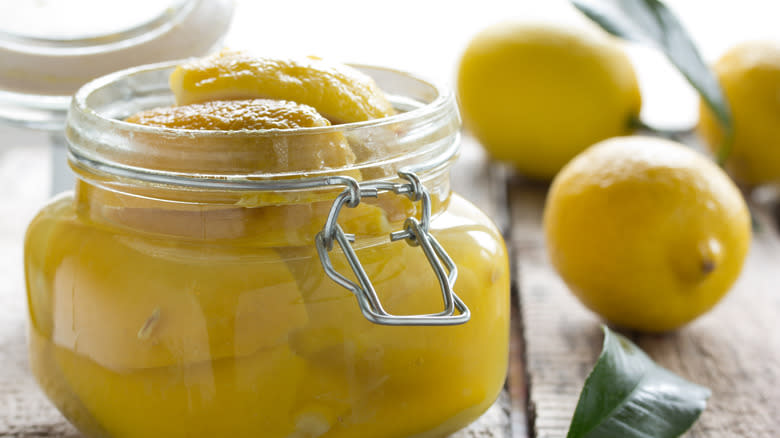Vietnamese Vs Moroccan Preserved Lemons: What's The Difference?

Preserving food is an ancient practice that's just as important today, with emphasis not only on shelf life but also culinary artistry and creativity. Salt preservation is typical for savory vegetables, meat, fish, and even sweet fruit as these two respective taste pairings are highly compatible. However salt preserving ultra sour lemons is the unexpected yet longstanding practice that produces a wonderfully complex seasoning agent.
The salt, mixed with the acid from the lemon, essentially pickles the lemon, softening it and creating a trifecta of umami, sour, and salty flavors that'll add depth to a wide variety of dishes. Lemons are integral to Mediterranean cuisines, so you may have heard of Moroccan preserved lemons, but Vietnamese cuisine also utilizes them.
There are, however, key differences between Moroccan and Vietnamese preserved lemons that encompass both methodology and usage. Read on to discover how each culture preserves lemons and how they use them as a culinary and wellness element.
Read more: Vinegar Cooking Hacks You'll Wish You Knew Sooner
How To Use Vietnamese Preserved Lemons

The Vietnamese call preserved lemons chanh mu?i, which translates to "salt lemon." Lemons aren't common in Southeast Asia, so the original recipe for preserved lemons used limes. Limes are still used for chanh mu?i, but lemons have become a popular variation since their introduction into Vietnamese agriculture over the past few decades.
To make Vietnamese preserved lemons, the common procedure involves preservation in a salt brine. Some recipes first boil whole lemons first to make their skin more porous before adding them to a jar and topping them with boiled salt water. Chanh mu?i needs a minimum of three months to ferment in a tightly sealed jar, with many recipes recommending up to a year for maximum flavor and texture.
The most famous use for chanh mu?i is nuoc chanh mu?i, or salty lemonade made by muddling preserved lemons with a bit of sugar and topping them off with water or soda water. Salty lemonade is a refreshing and unique balance of salty, sour, savory, and sweet, offered in restaurants and households to beat the heat. In fact, you can even find bottled salty lemonade or salty lemonade concentrate from Vietnamese brands. Even Alton Brown has begun using preserved lemons in his lemonade.
Preserved lemons are also a common all-purpose remedy in Vietnam. People slice and muddle them to serve in hot or cold infusions with a serving of honey to treat everything from nausea to flu-like symptoms.
Making The Most Of Moroccan Preserved Lemons

Preserved lemons are said to have originated in North Africa. Consequently, Moroccan preserved lemons have an older history and much wider use in recipes compared with Vietnamese preserved lemons.
Moroccan preserved lemons are also prepared differently than Vietnamese chanh mu?i. Instead of brine fermentation, Moroccan customs butterfly lemons by making four criss-crossing incisions. Then, the incisions are packed with salt and the lemons are tightly packed inside of a jar with more salt and a squeeze of lemon juice. Some recipes recommend cutting the lemons into wedges for faster fermentation.
The Moroccan method is more involved than the Vietnamese method, requiring you to open the jar and pack even more salted lemons in during the first week or so of fermentation. Similar to Vietnamese recipes, a minimum of a month or two is required for their fermentation. But the longer the waiting period, the more subtle and palatable the flavor and texture. More modern recipes recommend adding common Moroccan spices like cinnamon, bay leaves, and fresh herbs.
Preserved lemons are one of the most widely used condiments and flavoring agents in Morocco. They're sliced and used as garnishes with olives for salads, added into chicken tagines or other stewed lamb and beef dishes, and also make a delicious complement to stewed vegetables like cauliflower or this Moroccan eggplant.
Read the original article on Tasting Table.
